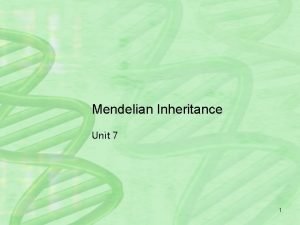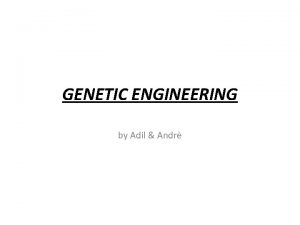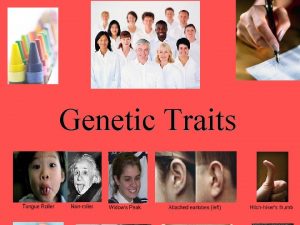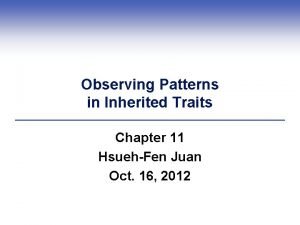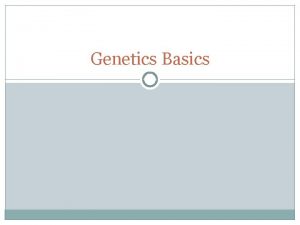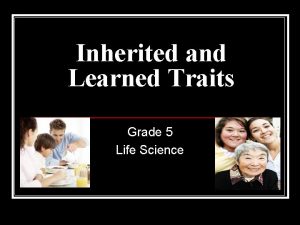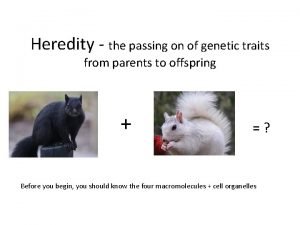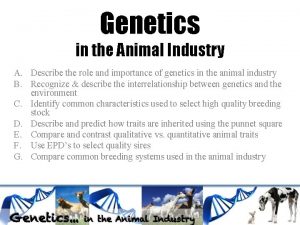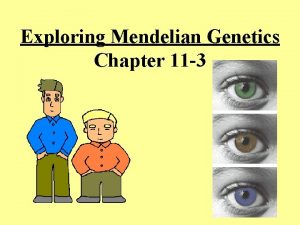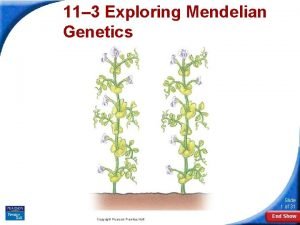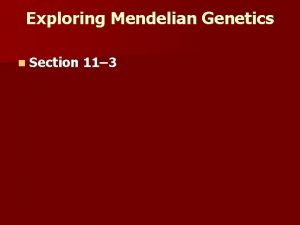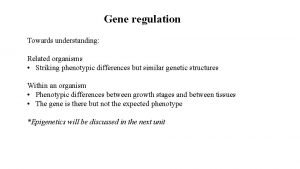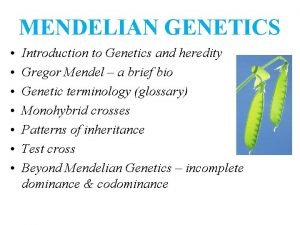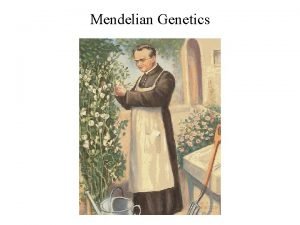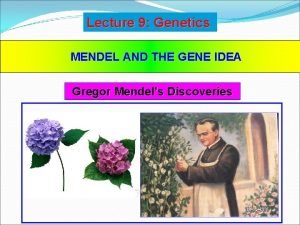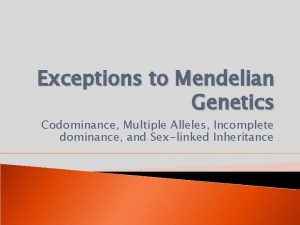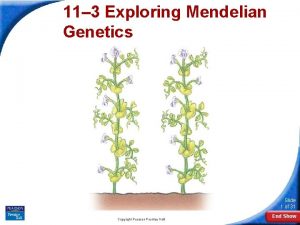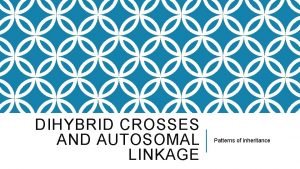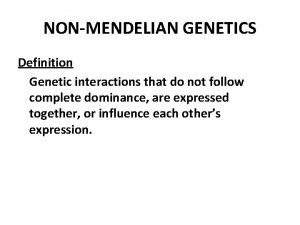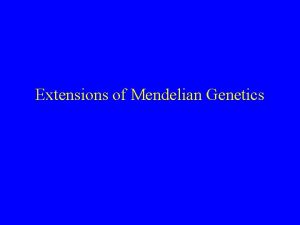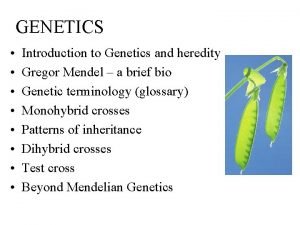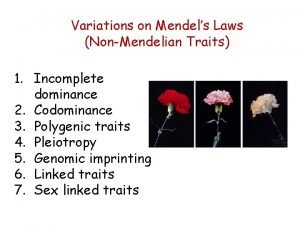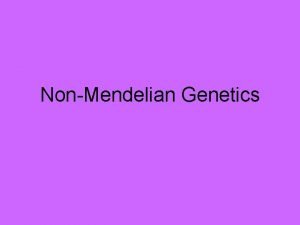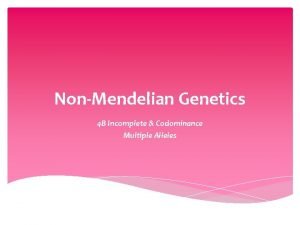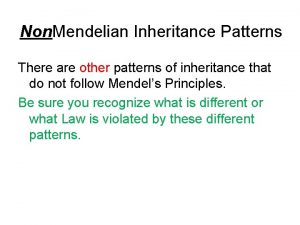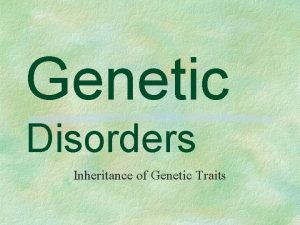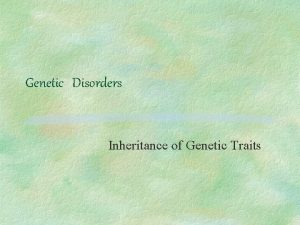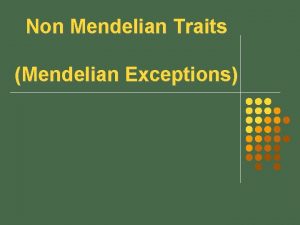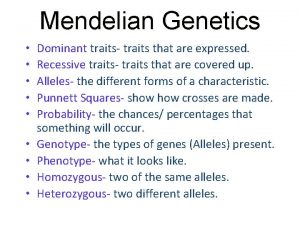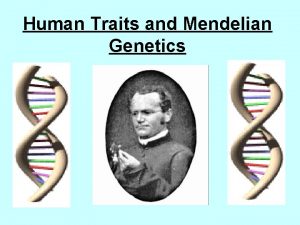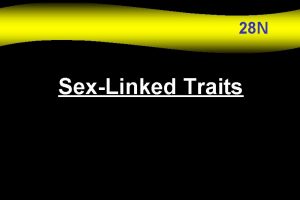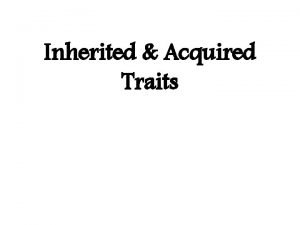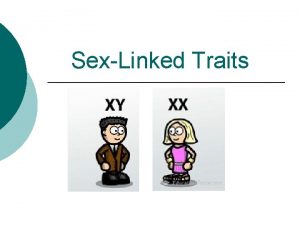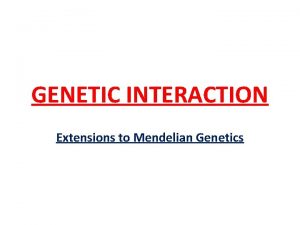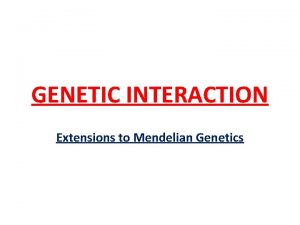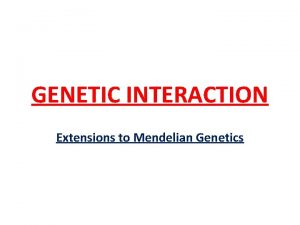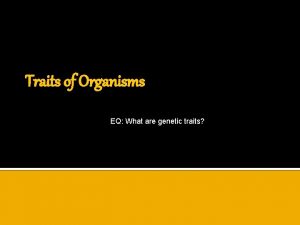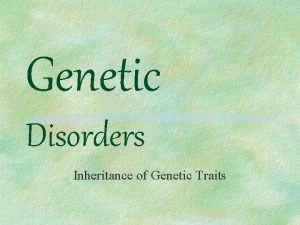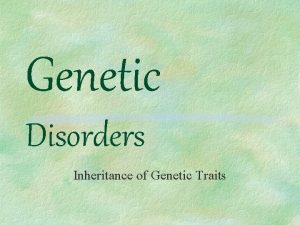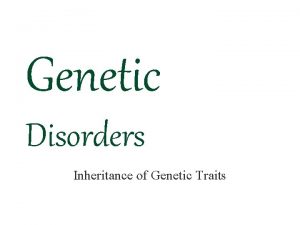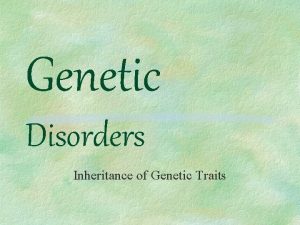Genetic Traits Mendelian traits in humans In Mendelian


















































- Slides: 50

Genetic Traits

Mendelian traits in humans • In Mendelian inheritance, a child receiving a dominant allele from either parent will have the dominant form of the phenotypic trait or characteristic. Only those that received the recessive allele from both parents, known as zygosity, will have the recessive phenotype. Those that receive a dominant allele from one parent and a recessive allele from the other parent will have the dominant form of the trait.

• Purely Mendelian traits are a tiny minority of all traits, since most phenotypic traits exhibit incomplete dominance, codominance, and contributions from many genes. • The recessive phenotype may theoretically skip any number of generations, lying dormant in heterozygous "carrier" individuals until they have children with someone who also has the recessive allele and both pass it on to their child. • The human Y chromosome is composed of about 59 million base pairs and is passed virtually unchanged from father to son. The mitochondrial DNA (mt. DNA) comes only from the mother and is given to both male and

Attached ear lobes are attached directly to the side of the head Earlobe Attachment

Some scientists have reported that this trait is due to a single gene for which unattached earlobes is dominant and an attached earlobe is recessive. Other scientists have reported that this trait is probably due to several genes.

Forelock White forelock (dominant trait) vs. No white forelock (recessive trait) A white forelock is a patch of white hair, usually located at the hairline. Widow's Peak (below) is dominant over no widow's peak hairline.

Broad Nose Narrow Nose Broad Nose - nostrils extend beyond the space between the eyes Narrow Nose - nostril span restricted to the space between the eyes

Thumb Extension

This trait is reportedly due to a single gene. Straight thumb (dominant trait) vs. Curved thumb (recessive trait) When viewed from the side as in the illustration below, curved thumbs can be seen as part of a circle.

Bent Little Finger A dominant allele causes the last joint of the little finger to dramatically bend inward toward the 4 th finger. Lay both hands flat on a table relax your muscles, and note whether you have a bent or straight little finger.

Mid-digital Hair Some people have hair on the middle segment of one or more of their fingers, while others don't. Having any hair there at all means that you have the dominant phenotype. Complete absence of hair is recessive.

Pinky: Straight pinky (recessive trait) vs. Bent pinky (dominant trait)

Longer 2 nd toe is dominant over 2 nd toe shorter than big toe.

Tongue Rolling 70% of people of European ancestry could roll their tongues and the remaining 30% could not.

Tongue rolling ability may be due to a single gene with the ability to roll the tongue a dominant trait and the lack of tongue rolling ability a recessive trait. However, many twins do not share the trait, so it may not be inherited.

Dimples

Dimples are reportedly due to a single gene with dimples dominant (people may exibit a dimple on only one side of the face) and a lack of dimples is recessive. Cleft chin is dominant over no cleft

Dimples are highly heritable, meaning that people who have dimples tend to have children with dimples—but not always. Because their inheritance isn't completely predictable, dimples are considered an “irregular” dominant trait. Having dimples is probably controlled mainly by one gene but also influenced by other genes.

Handedness

Overall, about 10% of people are left-handed, but the number varies among cultures from 0. 5% to 24%. Some scientists have reported that handedness is due to a single gene with right handedness dominant and left handedness recessive. Multiple studies present evidence that handedness is controlled by many genes—at least 30 and as many as 100—each with a small effect; many are linked to brain development. Environment also plays an important role: some cultures actively discourage left-handedness.

Freckles are small, concentrated spots of a skin pigment called melanin. Most fair-skinned, redhaired people have them.

Freckles are controlled primarily by the MC 1 R gene. Freckles show a dominant inheritance pattern: parents who have freckles tend to have children with freckles. This trait is reportedly due to a single gene’ the presence of freckles is dominant, the absence of freckles is recessive.

Curly Hair

Early geneticists reported that curly hair was dominant and strait hair was recessive. More recent scientists believe that more than one gene may be involved.

Multiple genes control hair texture, and different variations in these genes are found in different populations. For instance, curly hair is common in African populations, rare in Asian populations, and in-between in Europeans. Straight hair in Asians is mostly caused by variations in two genes— different genes from the ones that influence hair texture in Europeans. And different genetic variations make hair curly in African and European populations.

Hand clasping

One study found that 55% of people place their left thumb on top, 45% place their right thumb on top, and 1% have no preference. A study of identical twins concluded that hand clasping has a strong genetic basis (most twins share the trait), but it doesn’t fit a predictable inheritance pattern. It is likely affected by multiple genes as well as environmental factors.

Allergies

While allergic reactions are induced by things a person comes in contact with, such as dust, particular foods, and pollen, the tendency to have allergies is inherited. If a parent has allergies, there is a one in four (25%) chance that their child will also have allergy problems. The risk increases if both parents have allergies.

Eye Color Eye color, as well as hair and skin, is a complex trait; not a case of simple inheritance. The main pigment is melanin, and the more melanin, the darker the color. Although the genetics of eye color is complex, alleles for production of melanin dominate those for lack of melanin. So if we evaluate eye color as brown (dominant) or nonbrown (recessive), it can be treated as a characteristic of simple inheritance.

Color blindness


Color blindness is due to a recessive allele located on the X chromosome. Women have two X chromosomes, one of which usually carries the allele for normal color vision. Therefore, few women are colorblind. Men only have one X chromosome, so if they carry the allele for color blindness, they will exhibit this trait. Thus, color blindness is seen more frequently in men than in women.

Red-green color blindness follows a very predictable recessive, sex-linked inheritance pattern. A woman with one defective copy of the gene and one functional copy, even though she is not colorblind herself, is known as a "carrier. " She has a 50% chance of passing the defective copy to each of her children. Half of her sons will be colorblind, and half of her daughters will be carriers.

The differences between identical twins don't come from DNA—they all come from external factors.

Identical twins: same DNA, different environment Identical twins have exactly the same DNA, but they are not exactly alike. Each twin has his or her own personality, talents, likes, and dislikes. There are even diseases that appear in one twin but not the other, including arthritis, diabetes, autism, schizophrenia, cancer, and many others. The differences between identical twins don't come from DNA—they all come from external factors.

PTC tasting

To about 75% of us, the chemical PTC (phenylthiocarbamide) tastes very bitter. For the other 25%, it is tasteless. The ability to taste PTC is controlled mainly by a single gene that codes for a bitter-taste receptor on the tongue. Different variations, or alleles, of this gene control whether PTC tastes bitter or not. PTC tasting follows a very predictable pattern of inheritance. Tasting is dominant, meaning that if you have at least one copy of the tasting version of the gene, you can taste PTC. Non-tasters have two copies of the non-tasting allele.

Achoo Syndrome This dominant trait is also called the photo sneeze reflex. If, when suddenly exposed to light, you sneeze (usually two or three times) you have the genes for achoo syndrome. Next time you go to a movie, exit the dark theater through a door that leads directly outside. It's fun to wait outside and watch the people emerge from the movie. Some will sneeze as soon as they are exposed to light.

Summary Recessive Dominant High heart rate Low heart rate straight hair line Widow's peak Hypotelorism ocular hypertelorism POLIP syndrome normal digestive muscle No facial dimples Facial dimples * Unable to taste PTC Attached earlobe Unattached (free) earlobe Counter-Clockwise hair direction (right to left) Clockwise hair direction (left to right) smooth chin Cleft chin turned up nose straight nose

Recessive Dominant Normal five fingers and toes extra finger or toe Crooked pinkies straight pinkies Hitchhiker's Thumb Straight Thumb No freckles Freckles Dry-type earwax Wet-type earwax Straight hair Curly hair No ability to roll tongue Ability to roll tongue (Able to hold tongue in a U shape) Normal finger length shortness in fingers O blood type A and B blood type Little body hair Abundant body hair Slender lips Broad lips narrow nose Broad nose

Recessive Dominant Low blood pressure High blood pressure Normal separated fingers Webbed fingers dominant right Thumb dominant left thumb Normal vision Nearsightedness no mid digit hair Mid digit hair big toe dominance Morton's toe no manus hair Hair on back of hand no prominent bridge Roman nose tall stature short stature none Migraines Small eyes large eyes

Recessive Dominant normal hearing tone deafness Lighter hair Darker hair Night blindness normal night vision same colour temple highlights different colour temple highlights regular size Clubbed thumb square shape oval-shaped face Joined eyebrow separated eyebrows short eyelashes long eyelashes normal body proportions Marfan's syndrome

Recessive Dominant no ACHOO reflex Photic sneeze reflex Cystic fibrosis normal mucus lining Dark Forelock White Forelock curved thumb Straight thumb Regular formed hip Upington disease can't move ears ability to move ears standard height Dwarfism Situs inversus right-sided heart situs solitus left-sided heart Ligamentous Laxity Ligamentous angustus Tay–Sachs disease normal mental abilities Galactosemia ability to eat sugar

Recessive Dominant strong collagen Ehlers–Danlos syndrome Low cholesterol High cholesterol strong connective tissue Shepherds Crook Rounded eye shape Almond eye shape three palmar tendons two palmar tendons eczema-free eczema hemochromatosis Type I, III hemochromatosis Type IV three wrist tendon two wrist tendons

Recessive Dominant narrow mouth pointed nose shape flared nostrils Wide mouth rounded nose shape rounded nostrils absence of blood birthmarks hair on earlobes hemangiomas no hair on earlobes no appearance of body inflammation Familial Mediterranean fever straight formed limbs slanted eyes lighter eyebrows than normal hair * no protruding lip or chin Boomerang dysplasia straight eyes darker eyebrows than normal hair * Hapsburg lip

Recessive Dominant Trimethylaminuria Absence of fish-like body odour Madelung's deformity Straight flush wrist no missing teeth straight teeth oligodontia crooked teeth Normal brain chemistry Anxiety attacks Adenosine deaminase deficiency Presence of immune system partial leukonychia Total leukonychia and Bart pumphrey syndrome

Recessive Dominant little sweating in hands primary hyperhidrosis no retention of fold Mongolian Fold hair present on temples Triangular alopecia small nose Large nose absence of ear pit Ear pit (congenital appearance of a hole) accelerated aging Slower aging Carpenter syndrome lack of deformities susceptibility to poison ivy immunity to poison ivy Cartilage–hair hypoplasia normal height

Recessive Dominant Thalassemia Normal hemoglobin synthesis Thin hair (diameter) Thick hair(diameter) Bloom syndrome decreased risk of cancer Pendred syndrome congenital hearing loss lack of fatal insomnia Fatal familial insomnia Lactose intolerance * Lactose persistence * less prominent chin (Ushaped) Prominent chin (V-shaped) Clear complexion Acne prone

END
 Difference between mendelian and non mendelian inheritance
Difference between mendelian and non mendelian inheritance Pros and cons of biotechnology
Pros and cons of biotechnology Banofge
Banofge Genetic drift vs gene flow
Genetic drift vs gene flow What is the difference between genetic drift and gene flow
What is the difference between genetic drift and gene flow Genetic drift vs genetic flow
Genetic drift vs genetic flow Genetic programming vs genetic algorithm
Genetic programming vs genetic algorithm Genetic programming vs genetic algorithm
Genetic programming vs genetic algorithm Mendelian traits
Mendelian traits Who was mendal
Who was mendal Mendelian traits
Mendelian traits An introduction to mendelian genetics
An introduction to mendelian genetics Example of abiotic factor
Example of abiotic factor Baby skin colour predictor
Baby skin colour predictor Examples of co dominance
Examples of co dominance Examples of acquired traits in humans
Examples of acquired traits in humans Polyploid
Polyploid Who is gregor mendel
Who is gregor mendel Traits
Traits Qualitative traits vs quantitative traits
Qualitative traits vs quantitative traits Qualitative traits vs quantitative traits
Qualitative traits vs quantitative traits Qualitative traits vs quantitative traits
Qualitative traits vs quantitative traits Section 11-3 exploring mendelian genetics
Section 11-3 exploring mendelian genetics 11-3 exploring mendelian genetics
11-3 exploring mendelian genetics Section 11-3 exploring mendelian genetics
Section 11-3 exploring mendelian genetics Mendelian
Mendelian Mendelian slicer
Mendelian slicer Codominant
Codominant Probability laws govern mendelian inheritance
Probability laws govern mendelian inheritance Cystic fibrosis mendelian inheritance
Cystic fibrosis mendelian inheritance Mendelian randomisation
Mendelian randomisation Mendelian genetics concept map
Mendelian genetics concept map Punnet sqaure
Punnet sqaure Exceptions to mendelian genetics
Exceptions to mendelian genetics 11-3 exploring mendelian genetics answers
11-3 exploring mendelian genetics answers Chapter 10 section 2: mendelian genetics
Chapter 10 section 2: mendelian genetics Mendelian ratios
Mendelian ratios Dihybrid cross
Dihybrid cross Mendelian laws
Mendelian laws Mendelian genetics definition
Mendelian genetics definition Karyotype
Karyotype Section 11-3 exploring mendelian genetics answer key
Section 11-3 exploring mendelian genetics answer key Recessive epistasis in mice
Recessive epistasis in mice Chapter 7 extending mendelian genetics vocabulary practice
Chapter 7 extending mendelian genetics vocabulary practice Genotype
Genotype Extending mendelian genetics
Extending mendelian genetics Non mendelian law
Non mendelian law Non mendelian inheritance
Non mendelian inheritance Codominance definition
Codominance definition Mendelian inheritance patterns
Mendelian inheritance patterns Pedigree miscarriage symbol
Pedigree miscarriage symbol
